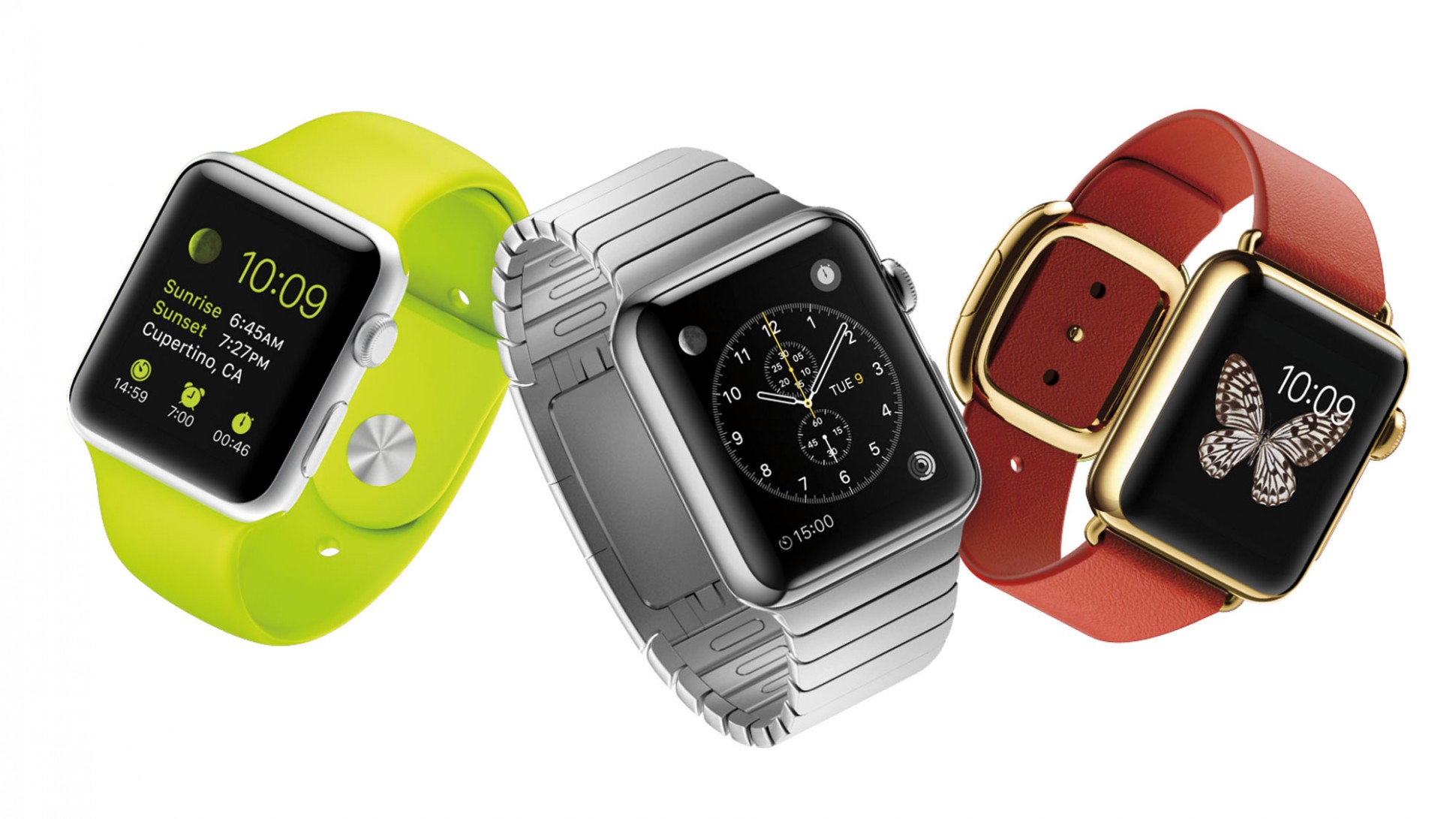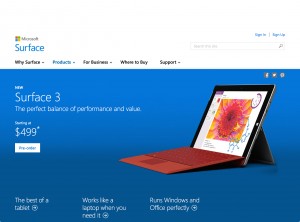
by Adam Hartung | Apr 2, 2015 | Current Affairs, Defend & Extend, In the Rapids, Innovation, Leadership, Web/Tech
Microsoft launched its new Surface 3 this week, and it has been gathering rave reviews. Many analysts think its combination of a full Windows OS (not the slimmed down RT version on previous Surface tablets,) thinness and ability to operate as both a tablet and a PC make it a great product for business. And at $499 it is cheaper than any tablet from market pioneer Apple.

Meanwhile Apple keeps promoting the new Apple Watch, which was debuted last month and is scheduled to release April 24. It is a new product in a market segment (wearables) which has had very little development, and very few competitive products. While there is a lot of hoopla, there are also a lot of skeptics who wonder why anyone would buy an Apple Watch. And these skeptics worry Apple’s Watch risks diverting the company’s focus away from profitable tablet sales as competitors hone their offerings.

Looking at these launches gives a lot of insight into how these two companies think, and the way they compete. One clearly lives in red oceans, the other focuses on blue oceans.
Blue Ocean Strategy (Chan Kim and Renee Mauborgne) was released in 2005 by Harvard Business School Press. It became a huge best-seller, and remains popular today. The thesis is that most companies focus on competing against rivals for share in existing markets. Competition intensifies, features blossom, prices decline and the marketplace loses margin as competitors rush to sell cheaper products in order to maintain share. In this competitively intense ocean segments are niched and products are commoditized turning the water red (either the red ink of losses, or the blood of flailing competitors, choose your preferred metaphor.)
On the other hand, companies can choose to avoid this margin-eroding competitive intensity by choosing to put less energy into red oceans, and instead pioneer blue oceans – markets largely untapped by competition. By focusing beyond existing market demands companies can identify unmet needs (needs beyond lower price or incremental product improvements) and then innovate new solutions which create far more profitable uncontested markets – blue oceans.
Obviously, the authors are not big fans of operational excellence and a focus on execution, but instead see more value for shareholders and employees from innovation and new market development.
If we look at the new Surface 3 we see what looks to be a very good product. Certainly a product which is competitive. The Surface 3 has great specifications, a lot of adaptability and meets many user needs – and it is available at what appears to be a favorable price when compared with iPads.
But …. it is being launched into a very, very red ocean.
The market for inexpensive personal computing devices is filled with a lot of products. Don’t forget that before we had tablets we had netbooks. Low cost, scaled back yet very useful Microsoft-based PCs which can be purchased at prices that are less than half the cost of a Surface 3. And although Surface 3 can be used as a tablet, the number of apps is a fraction of competitive iOS and Android products – and the developer community has not yet embraced creating new apps for Windows tablets. So Surface 3 is more than a netbook, but also a lot more expensive.
Additionally, the market has Chromebooks which are low-cost devices using Google Chrome which give most of the capability users need, plus extensive internet/cloud application access at prices less than a third that of Surface 3. In fact, amidst the Microsoft and Apple announcements Google announced it was releasing a new ChromeBit stick which could be plugged into any monitor, then work with any Bluetooth enabled keyboard and mouse, to turn your TV into a computer. And this is expected to sell for as little as $100 – or maybe less!

This is classic red ocean behavior. The market is being fragmented into things that work as PCs, things that work as tablets (meaning run apps instead of applications,) things that deliver the functionality of one or the other but without traditional hardware, and things that are a hybrid of both. And prices are plummeting. Intense competition, multiple suppliers and eroding margins.
Ouch. The “winners” in this market will undoubtedly generate sales. But, will they make decent profits? At low initial prices, and software that is either deeply discounted or free (Google’s cloud-based MSOffice competitive products are free, and buyers of Surface 3 receive 1 year free of MS365 Office in the cloud, as well as free upgrade to Windows 10,) it is far from obvious how profitable these products will be.
Amidst this intense competition for sales of tablets and other low-end devices, Apple seems to be completely focused on selling a product that not many people seem to want. At least not yet. In one of the quirkier product launch messages that’s been used, Apple is saying it developed the Apple Watch because its other innovative product line – the iPhone – “is ruining your life.”
Apple is saying that its leaders have looked into the future, and they think today’s technology is going to move onto our bodies. Become far more personal. More interactive, more knowledgeable about its owner, and more capable of being helpful without being an interruption. They see a future where we don’t need a keyboard, mouse or other artificial interface to connect to technology that improves our productivity.
Right. That is easy to discount. Apple’s leaders are betting on a vision. Not a market. They could be right. Or they could be wrong. They want us to trust them. Meanwhile, if tablet sales falter….. if Surface 3 and ChromeBit do steal the “low end” – or some other segment – of the tablet market…..if smartphone sales slip….. if other “forward looking” products like ApplePay and iBeacon don’t catch on……
This week we see two companies fundamentally different methods of competing. Microsoft thinks in relation to its historical core markets, and engaging in bloody battles to win share. Microsoft looks at existing markets – in this case tablets – and thinks about what it has to do to win sales/share at all cost. Microsoft is a red ocean competitor.
Apple, on the other hand, pioneers new markets. Nobody needed an iPod… folks were happy enough with Sony Walkman and Discman. Everybody loved their Razr phones and Blackberries… until Apple gave them an iPhone and an armload of apps. Netbook sales were skyrocketing until iPads came along providing greater mobility and a different way of getting the job done.
Apple’s success has not been built upon defending historical markets. Rather, it has pioneered new markets that made existing markets obsolete. Its success has never looked obvious. Contrarily, many of its products looked quite underwhelming when launched. Questionable. And it has cannibalized its own products as it brought out new ones (remember when iPods were so new there was the iPod mini, iPod nano and iPod Touch? After 5 years of declining iPod sale Apple has stopped reporting them.) Apple avoids red oceans, and prefers to develop blue ones.
Which company will be more successful in 2020? Time will tell. But, since 2000 Apple has gone from nearly bankrupt to the most valuable publicly traded company in the USA. Since 1/1/2001 Microsoft has gone up 32% in value. Apple has risen 8,000%. While most of us prefer the competition in red oceans, so far Apple has demonstrated what Blue Ocean Strategy authors claimed, that it is more profitable to find blue oceans. And they’ve shown us they can do it.


by Adam Hartung | Nov 3, 2014 | Current Affairs, In the Rapids, Leadership, Web/Tech
On April 15 Zebra Technologies announced its planned acquisition of Motorola’s Enterprise Device Business. This was remarkable because it represented a major strategic shift for Zebra, and one that would take a massive investment in products and technologies which were wholly new to the company. A gutsy play to make Zebra more relevant in its B-2-B business as interest in its “core” bar code business was declining due to generic competition.
Last week the acquisition was completed. In an example of Jonah swallowing the whale, Zebra added $2.5B to annual revenues on its old base of $1B (2.5x incremental revenue,) an additional 4,500 employees joined its staff of 2,500 and 69 new facilities were added. Gulp.

As CEO Anders Gustafsson told me, “after the deal was agreed to I felt like the dog that caught the car. ”
Fortunately Zebra has a plan, and it is all around growth. Acquisitions led by private equity firms, hedge funds or leveraged buyout partners are usually quick to describe the “synergies” planned for after the acquisition. Synergy is a code word for massive cost cutting (usually meaning large layoffs,) selling off assets (from buildings to product lines and intellectual property rights) and shutting down what the buyers call “marginal” businesses. This always makes the company smaller, weaker and less likely to survive as the new investors focus on pulling out cash and selling the remnants to some large corporation.
There is no growth plan.
But Zebra has publicly announced that after this $3.25B investment they plan only $150M of savings over 2 years. Which means Zebra’s management team intends to grow what they bought, not decimate it. What a novel, or perhaps throwback, idea.
Minimal cost cutting reflects a deal, as CEO Gustafsson told me, “envisioned by management, not by bankers.”
Zebra’s management knew the company was frequently pitching for new work in partnership with Motorola. The two weren’t competitors, but rather two companies working to move their clients forward. But in a disorganized, unplanned way because they were two totally different companies. Zebra’s team recognized that if this became one unit, better planning for clients, the products could work better together, the solutions more directly target customer needs and it would be possible to slingshot forward ahead of competitors to grow revenues.
As CEO since 2007, Anders Gustafsson had pushed a strategy which could grow Zebra, and move the company outside its historical core business of bar code printers and readers. The leadership considered buying Symbol Technology, but wasn’t ready and watched it go to Motorola.
Then Zebra’s team knuckled down on their strategy work. CEO Gustafsson spelled out for me the 3 trends which were identified to build upon:
- Mobility would continue to be a secular growth trend. And business customers needed products with capabilities beyond the generic smart phone. For example, the kind of integrated data entry and printing device used at a remote rental car return. These devices drive business productivity, and customers hunger for such solutions.
- From the days of RFID, where Zebra was an early player, had emerged automatic data capture – which became what now is commonly called “The Internet of Things” – and this trend too had far to extend. By connecting the physical and digital worlds, in markets like retail inventory management, big productivity boosts were possible in formerly moribund work that added cost but little value.
- Cloud-based (SaaS and growth of lightweight apps) ecosystems were going to provide fast growth environments. Client need for capability at the employee’s (or their customer’s) fingertips would grow, and those people (think distributors, value added resellers [VARs]) who build solutions will create apps, accessible via the cloud, to rapidly drive customer productivity.

With this groundwork, the management team developed future scenarios in which it became increasingly clear the value in merging together with Motorola devices to accelerate growth. According to CEO Gustafsson, “it would bring more digital voice to the Zebra physical voice. It would allow for more complete product offerings which would fulfill critical, macro customer trends.”
But, to pull this off required selling the Board of Directors. They are ultimately responsible for company investments, and this was – as described above – a “whopper.”
The CEO’s team spent a lot of time refining the message, to be clear about the benefits of this transaction. Rather than pitching the idea to the Board, they offered it as an opportunity to accelerate strategy implementation. Expecting a wide range of reactions, they were not surprised when some Directors thought this was “phenomenal” while others thought it was “fraught with risk.”
So management agreed to work with the Board to undertake a thorough due diligence process, over many weeks (or months it turned out) to ask all the questions. A key executive, who was a bit skeptical in her own right, took on the role of the “black hat” leader. Her job was to challenge the many ideas offered, and to be a chronic skeptic; to not let the team become enraptured with the idea and thereby sell themselves on success too early, and/or not consider risks thoroughly enough. By persistently undertaking analysis, education led the Board to agree that management’s strategy had merit, and this deal would be a breakout for Zebra.
Next came completing financing. This was a big deal. And the only way to make it happen was for Zebra to take on far more debt than ever in the company’s history. But, the good news was that interest rates are at record low levels, so the cost was manageable.
Zebra’s leadership patiently met with bankers and investors to overview the market strategy, the future scenarios and their plans for the new company. They over and again demonstrated the soundness of their strategy, and the cash flow ability to service the debt. Zebra had been a smaller, stable company. The debt added more dynamism, as did the much greater revenues. The requirement was to decide if the strategy was soundly based on trends, and had a high likelihood of success. Quickly enough, the large shareholders agreed with the path forward, and the financing was fully committed.
Now that the acquisition is complete we will all watch carefully to see if the growth machine this leadership team created brings to market the solutions customers want, so Zebra can generate the revenue and profits investors want. If it does, it will be a big win for not only investors but Zebra’s employees, suppliers and the communities in which Zebra operates.
The obvious question has to be, why didn’t Motorola do this deal? After all, they were the whale. It would have been much easier for people to understand Motorola buying Zebra than the gutsy deal which ultimately happened.
Answering this question requires a lot more thought about history. In 2006 Motorola had launched the Razr phone and was an industry darling. Newly minted CEO Ed Zander started partnering with Google and Apple rather than developing proprietary solutions like Razr. Carl Icahn soon showed up as an activist investor intent on restructuring the company and pulling out more cash. Quickly then-CEO Ed Zander was pushed out the door. New leadership came in, and Motorola’s new product introductions disappeared.
Under pressure from Mr. Icahn, Motorola started shrinking under direction of the new CEO. R&D and product development went through many cuts. New product launches simply were delayed, and died. The cellular phone business began losing money as RIM brought to market Blackberry and stole the enterprise show. Year after year the focus was on how to raise cash at Motorola, not how to grow.
After 4 years, Mr. Icahn was losing money on his position in Motorola. A year later Motorola spun out the phone business, and a year after that leadership paid Mr. Icahn $1.2B in a stock repurchase that saved him from losses. The CEO called this buyout of Icahn the “end of a journey” as Mr. Icahn took the money and ran. How this benefited Motorola is – let’s say unclear.
But left in Icahn’s wake was a culture of cut and shred, rather than invest. After 90 years of invention, from Army 2-way radios to police radios, from AM car radios to home televisions, the inventor analog and digital cell towers and phones, there was no more innovation at Motorola. Motorola had become a company where the leaders, and Board, only thought about how to raise cash – not deploy it effectively within the corporation. There was very little talk about how to create new markets, but plenty about how to retrench to ever smaller “core” markets with no sales growth and declining margins. In September of this year long-term CEO Greg Brown showed no insight for what the company can become, but offered plenty of thoughts on defending tax inversions and took the mantle as apologist for CEOs who use financial machinations to confuse investors.
Investors today should cheer the leadership, in management and on the Board, at Zebra. Rather than thinking small, they thought big. Rather than bragging about their past, they figured out what future they could create. Rather than looking at their limits, they looked at the possibilities. Rather than giving up in the face of objections, they studied the challenges until they had answers. Rather than remaining stuck in their old status quo, they found the courage to become something new.
Bravo.
by Adam Hartung | Nov 29, 2012 | Defend & Extend, In the Swamp, In the Whirlpool, Leadership, Web/Tech
The web lit up yesterday when people started sharing a Fortune quote from Marissa Mayer, CEO of Yahoo, "We are literally moving the company from BlackBerrys to smartphones." Why was this a big deal? Because, in just a few words, Ms. Mayer pointed out that Research In Motion is no longer relevant. The company may have created the smartphone market, but now its products are so irrelevant that it isn't even considered a market participant.
Ouch. But, more importantly, this drove home that no matter how good RIM thinks Blackberry 10 may be, nobody cares. And when nobody cares, nobody buys. And if you weren't convinced RIM was headed for lousy returns and bankruptcy before, you certainly should be now.
But wait, this is certainly a good bit of the pot being derogatory toward the kettle. Because, other than the highly personalized news about Yahoo's new CEO, very few people care about Yahoo these days as well. After being thoroughly trounced in ad placement and search by Google, it is wholly unclear how Yahoo will create its own relevancy. It may likely be soon when a major advertiser says "When placing our major internet ad program we are focused on the split between Google and Facebook," demonstrating that nobody really cares about Yahoo anymore, either.
And how long will Yahoo survive?
The slip into irrelevancy is the inflection point into failure. Very few companies ever return. Once you are no longer relevant, customer quickly stop paying attention to practically anything you do. Even if you were once great, it doesn't take long before the slide into no-growth, cost cutting and lousy financial performance happens.
Consider:
- Garmin once led the market for navigation devices. Now practically everyone uses their mobile phone for navigation. The big story is Apple's blunder with maps, while Google dominates the marketplace. You probably even forgot Garmin exists.
- Radio Shack once was a consumer electronics powerhouse. They ran superbowl ads, and had major actresses parlaying with professional sports celebrities in major network ads. When was the last time you even thought about Radio Shack, much less visited a store?
- Sears was once America's premier, #1 retailer. The place where everyone shopped for brands like Craftsman, DieHard and Kenmore. But when did you last go into a Sears? Or even consider going into one? Do you even know where one is located?
- Kodak invented amateur photography. But when that market went digital nobody cared about film any more. Now Kodak is in bankruptcy. Do you care?
- Motorola Razr phones dominated the last wave of traditional cell phones. As sales plummeted they flirted with bankruptcy, until Motorola split into 2 pieces and the money losing phone business became Google – and nobody even noticed.
- When was the last time you thought about "building your body 12 ways" with Wonder bread? Right. Nobody else did either. Now Hostess is liquidating.
Being relevant is incredibly important, because markets shift quickly today. As they shift, either you are part of the trend going forward – or you are part of the "who cares" past. If you are the former, you are focused on new products that customers want to evaluate. If you are the latter, you can disappear a whole lot faster than anyone expected as customers simply ignore you.
So now take a look at a few other easy-to-spot companies losing relevancy:
- HP headlines are dominated by write offs of its investments in services and software, causing people to doubt the viability of its CEO, Meg Whitman. Who wants to buy products from a company that would spend billions on Palm, business services and Autonomy ERP software only to decide they overspent and can never make any money on those investments? Once a great market leader, HP is rapidly becoming a company nobody cares about; except for what appears to be a bloody train wreck in the making. In tech – lose customesr and you have a short half-life.
- Similarly Dell. A leader in supply chain management, what Dell product now excites you? As you think about the money you will spend this holiday, or in 2013, on tech products you're thinking about mobile devices — and where is Dell?
- Best Buy was the big winner when Circuit City went bankrupt. But Best Guy didn't change, and now margins have cratered as people showroom Amazon while in their store to negotiate prices. How long can Best Buy survive when all TVs are the same, and price is all that matters? And you download all your music and movies?
- Wal-Mart has built a huge on-line business. Did you know that? Do you care? Regardless of Wal-mart's on-line efforts, the company is known for cheap looking stores with cheap merchandise and customers that can't maintain credit cards. When you look at trends in retailing, is Wal-Mart ever the leader – in anything – anymore? If not, Wal-mart becomes a "default" store location when all you care about is price, and you can't wait for an on-line delivery. Unless you decide to go to the even cheaper Dollar General or Aldi.
And, the best for last, is Microsoft. Steve Ballmer announced that Microsoft phone sales quadrupled! Only, at 4 million units last quarter that is about 10% of Apple or Android. Truth is, despite 3 years of development, a huge amount of pre-release PR and ad spending, nobody much cares about Win8, Surface or new Microsoft-based mobile phones. People want an iPhone or Samsung product.
After its "lost decade" when Microsoft simply missed every major technology shift, people now don't really care about Microsoft. Yes, it has a few stores – but they dwarfed in number and customers by the Apple stores. Yes, the shifting tiles and touch screen PCs are new – but nobody real talks about them; other than to say they take a lot of new training. When it comes to "game changers" that are pushing trends, nobody is putting Microsoft in that category.
So the bad news about a $6 billion write-down of aQuantive adds to the sense of "the gang that can't shoot straight" after the string of failures like Zune, Vista and early Microsoft phones and tablets. Not to mention the lack of interest in Skype, while Internet Explorer falls to #2 in browser market share behind Chrome.
 Chart Courtesy Jay Yarrow, BusinessInsider.com 5-21-12
Chart Courtesy Jay Yarrow, BusinessInsider.com 5-21-12
When a company is seen as never able to take the lead amidst changing
trends, investors see accquisitions like $1.2B for Yammer as a likely future write down. Customers lose interest and simply spend money elsewhere.
As investors we often hear about companies that were once great brands, but selling at low multiples, and therefore "value plays." But the truth is these are death traps that wipe out returns. Why? These companies have lost relevancy, and that puts them one short step from failure.
As company managers, where are you investing? Are you struggling to be relevant as other competitors – maybe "fringe" companies that use "voodoo solutions" you don't consider "enterprise ready" or understand – are obtaining a lot more interest and media excitment? You can work all you want to defend & extend your past glory, but as markets shift it is amazingly easy to lose relevancy. And it's a very, very tough job to play catch- up.
Just look at the money being spent trying at RIM, Microsoft, HP, Dell, Yahoo…………
–
by Adam Hartung | Jul 14, 2011 | Investing, Leadership, Trends
When you go after competitors, does it more resemble a gladiator war – or a David vs. Goliath battle? The answer will likely determine your profitability. As a company, and as an investor.
After they achieve some success, most companies fall into a success formula – constantly tyring to improve execution. And if the market is growing quickly, this can work out OK. But eventually, competitors figure out how to copy your formula, and as growth slows many will catch you. Just think about how easily long distance companies caught the monopolist AT&T after deregulation. Or how quickly many competitors have been able to match Dell’s supply chain costs in PCs. Or how quickly dollar retailers – and even chains like Target – have been able to match the low prices at Wal-Mart.
These competitors end up in a gladiator war. They swing their price cuts, extended terms and other promotional weapons, leaving each other very bloody as they battle for sales and market share. Often, one or more competitors end up dead – like the old AT&T. Or Compaq. Or Circuit City. These gladiator wars are not a good thing for investors, because resources are chewed up in all the fighting, leaving no gains for higher dividends – nor any stock price appreciation. Like we’ve seen at Wal-Mart and Dell.
The old story of David and Goliath gives us a different approach. Instead of going “toe-to-toe” in battle, David came at the fight from a different direction – adopting his sling to throw stones while he remained safely out of Goliath’s reach. After enough peppering, he wore down the giant and eventually popped him in the head.
And that’s how much smarter people compete.
- When everyone was keen on retail stores to rent DVDs, Netflix avoided the gladiator war with Blockbuster by using mail delivery.
- While United, American, Continental, Delta, etc. fought each other toe-to-toe for customers in the hub-and-spoke airline wars (none making any money by the way) Southwest ferried people cheaply between smaller airports on direct flights. Southwest has made more money than all the “major” airlines combined.
- While Hertz, Avis, National, Thrifty, etc. spent billions competing for rental car customers at airports Enterprise went into the local communities with small offices, and now has twice their revenues and much higher profitability.
- When internet popularity started growing in the 1990s Netscape traded axe hits wtih Microsoft and was destroyed. Another browser pioneer, Spyglass, transitioned from PCs to avoid Microsoft, and started making browsers for mobile phones, TVs and other devices creating billions for investors.
- While GM, Ford and Chrysler were in a grinding battle for auto customers, spending billions on new models and sales programs, Honda brought to market small motorcycles and very practical, reliable small cars. Honda is now very profitable in several major markets, while the old gladiators struggle to survive.
As an investor, we should avoid buying stocks of companies, and management teams that allow themselves to be drug into gladiator wars. No matter what promises they make to succeed, their success is uncertain, and will be costly to obtain. What’s worse, they could win the gladiator war only to find themselves facing David – after they are exhausted and resources are spent!
- Research in Motion became embroiled in battles with traditional cell phone manufacturers like Nokia and Ericdson, and now is late to the smartphone app market – and with dwindling resources.
- Motorola fought the gladiator war trying to keep Razr phones competitive, only to completely miss its early lead in smartphones. Now it has limited resources to develop its Android smart phone line.
- Is it smart for Google to take on a gladiator war in social media against Facebook, when it doesn’t seem to have any special tool for the battle? What will this cost, while it simultaneously fights Apple in Android wars and Microsoft for Chrome sales?
On the other hand, it’s smart to invest in companies that enter growth markets, but have a new approach to drive customer conversion. For example, Zip Car rents autos by the hour for urban users. Most cars are very high mileage, which appeals to customers, but they also are pretty inexpensive to buy. Their approach doesn’t take-on the traditional car rental company, but is growing quite handily.
This same logic applies to internal company investments as well. Far too often the corporate reource allocation process is designed to fight a gladiator war. Constantly spending to do more of the same. Projects become over-funded to fight battles considered “necessity,” while new projects are unfunded despite having the opportunity for much higher rates of return.
In 2000, Apple could have chosen to keep pouring money into the Mac. Instead it radically cut spending, reduced Mac platforms, and started looking for new markets where it could bring in new solutions. IPods, iTunes, IPhones, iPads and iCloud are now driving growth for the company – all new approaches that avoided gladiator battles with old market competitors. Very profitable growth. Apple has enough cash on hand to buy every phone maker, except Samsung – or Apple could buy Dell – if it wanted to. Apple’s market cap is worth more than Microsoft and Intel combined.
If you want to make more money, it’s best to avoid gladiator wars. They are great spectator events – but terrible places to be a participant. Instead, set your organization to find new ways of competing, and invest where you are doing what competitors are not. That will earn the greatest rate of return.
by Adam Hartung | Nov 29, 2010 | Current Affairs, Disruptions, In the Rapids, Innovation, Leadership, Lifecycle, Openness, Television, Web/Tech
Summary:
- Most leaders optimize their core business
- This does not prepare the business for market shifts
- Motorola was a leader with Razr, but was killed when competitors matched their features and the market shifted to smart phones
- Netflix's leader is moving Netflix to capture the next big market (video downloads)
- Reed Hastings is doing a great job, and should be emulated
- Netflix is a great growth story, and a stock worth adding to your portfolio
"Reed Hastings: Leader of the Pack" is how Fortune magazine headlined its article making the Netflix CEO its BusinessPerson of the Year for 2010. At least part of Fortune's exuberance is tied to Netflix's dramatic valuation increase, up 200% in just the last year. Not bad for a stock called a "worthless piece of crap" in 2005 by a Wedbush Securities stock analyst. At the time, popular wisdom was that Blockbuster, WalMart and Amazon would drive Netflix into obscurity. One of these is now gone (Blockbuster) the other stalled (WalMart revenues unmoved in 2010) and the other well into digital delivery of books for its proprietary Kindle eReader.
But is this an honor, or a curse? It was 2004 when Ed Zander was given the same notice as the head of Motorola. After launching the Razr he was lauded as Motorola's stock jumped in price. But it didn't take long for the bloom to fall off that rose. Razr profits went negative as prices were cut to drive share increases, and a lack of new products drove Motorola into competitive obscurity. A joint venture with Apple to create Rokr gave Motorola no new sales, but opened Apple's eyes to the future of smartphone technology and paved the way for iPhone. Mr. Zander soon ran out of Chicago and back to Silicon Valley, unemployed, with his tale between his legs.
Netflix is a far different story from Motorola, and although its valuation is high looks like a company you should have in your portfolio.
Ed Zander simply took Motorola further out the cell phone curve that Motorola had once pioneered. He brought out the next version of something that had long been "core" to Motorola. It was easy for competitors to match the "features and functions" of Razr, and led to a price war. Mr. Zander failed because he did not recognize that launching smartphones would change the game, and while it would cannibalize existing cell phone sales it would pave the way for a much more profitable, and longer term greater growth, marketplace.
Looking at classic "S Curve" theory, Mr. Zander and Motorola kept pushing the wave of cell phones, but growth was plateauing as the technology was doing less to bring in new users (in the developed world):

Meanwhile, Research in Motion (RIM) was pioneering a new market for smartphones, which was growing at a faster clip. Apple, and later Google (with Android) added fuel to that market, causing it to explode. The "old" market for cell phones fell into a price war as the growth, and profits, moved to the newer technology and product sets:

The Motorola story is remarkably common. Companies develop leaders who understand one market, and have the skills to continue optimizing and exploiting that market. But these leaders rarely understand, prepare for and implement change created by a market shift. Inability to see these changes brought down Silicon Graphics and Sun Microsystems in 2010, and are pressuring Microsoft today as users are rapidly moving from laptops to mobile devices and cloud computing. It explains how Sony lost the top spot in music, which it dominated as a CD recording company and consumer electronics giant with Walkman, to Apple when the market moved people from physical CDs to MP3 files and Apple's iPod.
Which brings us back to what makes Netflix a great company, and Mr. Hastings a remarkable leader. Netflix pioneered the "ship to your home" DVD rental business. This helped eliminate the need for brick-and-mortar stores (along with other market trends such as the very inexpensive "Red Box" video kiosk and low-cost purchase options from the web.) Market shifts doomed Blockbuster, which remained locked-in to its traditional retail model, made obsolete by competitors that were cheaper and easier with which to do business.
But Netflix did not remain fixated on competing for DVD rentals and sales – on "protecting its core" business. Looking into the future, the organization could see that digital movie rentals are destined to be dramatically greater than physical DVDs. Although Hulu was a small competitor, and YouTube could be scoffed at as a Gen Y plaything, Netflix studied these "fringe" competitors and developed a superb solution that was the best of all worlds. Without abandoning its traditional business, Netflix calmly moved forward with its digital download business — which is cheaper than the traditional business and will not only cannibalize historical sales but make the traditional business completely obsolete!
Although text books talk about "jumping the curve" from one product line to another, it rarely happens. Devotion to the core business, and managing the processes which once led to success, keeps few companies from making the move. When it happens, like when IBM moved from mainframes to services, or Apple's more recent shift from Mac-centric to iPod/iPhone/iPad, we are fascinated. Or Google's move from search/ad placement company to software supplier. While any company can do it, few do. So it's no wonder that MediaPost.com headlines the Netflix transition story "Netflix Streams Its Way to Success."
Is Netflix worth its premium? Was Apple worth its premium earlier this decade? Was Google worth its premium during the first 3 years after its Initial Public Offering? Most investors fear the high valuations, and shy away. Reality is that when a company pioneers a growth business, the value is far higher than analysts estimate. Today, many traditionalists would say to stay with Comcast and set-top TV box makers like TiVo. But Comcast is trying to buy NBC in order to move beyond its shrinking subscriber base, and "TiVo Widens Loss, Misses Street" is the Reuters' headline. Both are clearly fighting the problems of "technology A" (above.)
What we've long accepted as the traditional modes of delivering entertainment are well into the plateau, while Netflix is taking the lead with "technology B." Buying into the traditionalists story is, well, like buying General Motors. Hard to see any growth there, only an ongoing, slow demise.
On the other hand, we know that increasingly young people are abandoning traditional programing for 100% entertainment selection by download. Modern televisions are computer monitors, capable of immediately viewing downloaded movies from a tablet or USB drive – and soon a built-in wifi connection. The growth of movie (and other video) watching is going to keep exploding – just as the volume of videos on YouTube has exploded. But it will be via new distribution. And nobody today appears close to having the future scenarios, delivery capability and solutions of Netflix. 24×7 Wall Street says Netflix will be one of "The Next 7 American Monopolies." The last time somebody used that kind of language was talking about Microsoft in the 1980s! So, what do you think that makes Netflix worth in 2012, or 2015?
Netflix is a great story. And likely a great investment as it takes on the market leadership for entertainment distribution. But the bigger story is how this could be applied to your company. Don't fear revenue cannibalization, or market shift. Instead, learn from, and behave like, Mr. Hastings. Develop scenarios of the future to which you can lead your company. Study fringe competitors for ways to offer new solutions. Be proactive about delivering what the market wants, and as the shift leader you can be remarkably well positioned to capture extremely high value.








